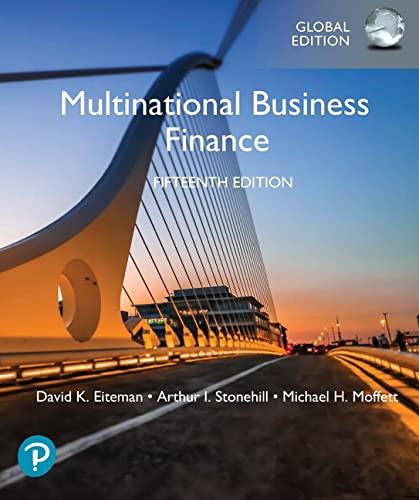Question
Case Study Practice (Part 2): Roberto Ortega is CEO and President of Healthy Drinks , which offers a private-labeled carbonated soft drink with similar tastes,
Case Study Practice (Part 2):
Roberto Ortega is CEO and President of Healthy Drinks, which offers a private-labeled carbonated soft drink with similar tastes, but at about half the price. Its products consist of regular cola carbonates and non-cola carbonates (lemon/lime or orange carbonates). While other soft drinks and beverages can be expensive, Ortega uses its cost savings and passes them off to consumers and customers. Healthy Drinks reports that its sustainable production processes allow for 330 grams of carbon dioxide emissions. Ortega wants to do more for the environment and lower-income customers. He recently learned that he can purchase a new piece of equipment, designed by someone he trusts, which will reduce the amount of carbon dioxide emissions to 100 grams.
The equipment broker outlines the project as follows:
The new machine costs $375,000.00 with installation/modification of $81,000.
Net working capital is projected to increase by $55,000 (mainly inventory, spare parts)
The machine is expected to generated $1,000,000 in sales in Year 1 and sales will grow by 10% in Years 2 and 3.
Costs are expected to be 50% of sales
Cannibalization costs of other drinks are expected to be $22,000 per year
Depreciation is reported using the straight-lined method
At the end of three years, the machines salvage value is projected to be $95,000
The tax rate is 35% and the cost of capital is 17%
Use this information and the past three years of financial statements located at the back of this case to answer the following questions:
1. Free Cash Flow and Ratios: Whether Mr. Ortega purchases the machine or not, Healthy Drinks must undergo a full financial audit. Please refer to the financial statements located on the last page. Calculate the following and pull together in the table format provided below.
a. Free Cash Flow and Economic Value Added for 2021 and 2020.
b. The following ratios for 2021, 2020, and 2019: Current ratio, Quick ratio, Days sales outstanding, Inventory turnover, Times interest earned (TIE), Debt ratio, Return on equity (ROE), Return on Assets (ROA), and Profit margin.
| 2021 | 2020 | ||
| Free Cash Flow | |||
| Economic Value Added | |||
| 2021 | 2020 | 2019 | |
| Current ratio | |||
| Quick ratio | |||
| Days sales outstanding | |||
| Inventory turnover | |||
| Times interest earned | |||
| Debt ratio | |||
| Return on equity | |||
| Return on assets | |||
| Profit margin |
2. Assess: Compare the answers you derived for Mr. Ortega to industry standards. If you worked for a bank and Mr. Ortega were to come to your bank for a loan, which financial indicators, if any, appear to be strong? Which financial indicators, if any, appear to be weak? Explain your answer.
3. Equity Financing: Suppose Mr. Ortega is thinking about listing his company publicly. He expects the following free cash flows for the next 3 years: 50% growth in Year 1*, 50% growth in Year 2, and 50% growth in Year 3. After that, growth would fall to a constant rate (8%) thereafter. WACC is 17% and investors require at least a 20% return. a. What is the fair (intrinsic) value of Mr. Ortegas stock?
b. If Goldman Sachs were to underwrite the offering and charge a 10% fee, what would be the fair price after Mr. Ortega pays the fees?
*In order to find the basis for Free Cash Flow in Year 1, take the free cash flow number you calculated Problem 3a. For example, if your Free Cash Flow was $10,000 in Problem 3a (Year 2021), your Year 1 Free Cash Flow would be $10,000 (1+.50) = $15,000.
Step by Step Solution
There are 3 Steps involved in it
Step: 1

Get Instant Access to Expert-Tailored Solutions
See step-by-step solutions with expert insights and AI powered tools for academic success
Step: 2

Step: 3

Ace Your Homework with AI
Get the answers you need in no time with our AI-driven, step-by-step assistance
Get Started


